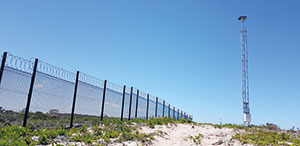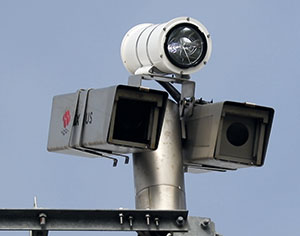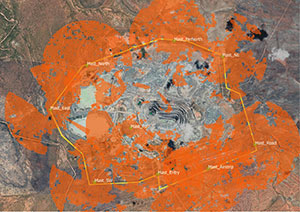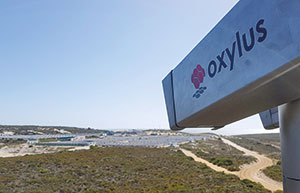

Traditional methods of securing perimeters offer limited capabilities when applied to the monitoring and protection of perimeters over a long range. Most physical barriers provide very limited protection and even the more sophisticated and expensive fences prove to be only a minor deterrent to a determined transgressor.
In addition to this, the response time of security teams is not always satisfactory on large properties. More often than not, however, the fault does not lie with the security teams, but should rather be attributed to the large distances that need to be covered by these teams. An additional challenge faced by security personnel is that even sophisticated cameras and fences are not always able to pinpoint the exact location of the transgression.

In order to effectively detect intrusions over large distances, cameras typically require narrow views (telephoto lenses) concentrating the pixels over the distant area. However, this comes at a price. These cameras with telephoto lenses can only cover small areas. This might be sufficient for perimeter monitoring down a straight fence line, but the fences do not always run straight, and these lenses are not adequate for area surveillance. As the costs associated with these cameras are relatively high, it is not viable to simply install large numbers of them to overcome this shortcoming. In addition to the narrow view and high price tag, large areas are not easily illuminated, leading to constraints related to visibility during hours of darkness.
Physical fences are often divided into sections to allow systems to monitor activity at certain locations along a fence line. Unfortunately, this approach does not provide fine-scale data that would allow one to accurately pinpoint the location of a potential threat along the disturbed section. A further shortcoming is that the system cannot identify whether the disturbance along the fence line is caused by the local wildlife, a single opportunist or a contingent of armed robbers.
Security companies generally implement approaches that secure only the perimeter of large properties. However, this approach addresses only a single aspect of securing a perimeter – providing a physical barrier and, once breached, a perpetrator can disappear in the large terrain. As mentioned earlier, physical barriers are only minor deterrents to determined transgressors. With advances in modern technology, more comprehensive solutions can be developed to provide effective and intelligent perimeter security.
Modern solutions
High-resolution cameras allow one to have sufficient resolution of the potential threat for identification purposes, along with wider viewing angles. Low-light cameras allow improved visibility during hours of darkness. Along with the advances in surveillance technology, we have also observed a drop in the price of thermal cameras and short-range radar solutions, making these options more viable for incorporation into security systems.

Despite these advances, most South Africans would agree that our country offers a number of practical problems that are not easily solved with pure technology. Large properties are often populated with wild animals, landscapes are characterised by uneven and variable terrain types, and daily and seasonal changes in lighting conditions are observed. These factors, along with various other challenges, should all be taken into account when designing wide-area surveillance solutions.
One option would be to cover the whole area with daylight and thermal cameras. However, although functionally acceptable, such a ‘brute force’ approach is not only unnecessarily expensive, but also destroys the natural ambience and aesthetic value of the area. This approach may also have a negative ecological impact, and the maintenance costs will be high.
A second solution would be to use scanning technologies like radar or optical scanning. Radar works on the principle of detecting motion and would be very successful in detecting intruders. However, radar systems are costly and often require special licences to operate. Radar is also limited in that it cannot easily identify potential threats as it is not able to distinguish between animals and humans, for example. Some of these limitations can be addressed by adding a camera with a high focal length to the system, which will allow one to zoom in on a potential threat for identification purposes. However, this will increase the cost of the total system and may not be a feasible option due to financial constraints.
Long-range optical solutions
A more modern approach incorporates the use of long focal length thermal cameras in a scanning action. This solution is significantly less costly compared to radar, making the placement of more sensors on the ground a more viable option, especially across undulating terrain. Like radar, this system can geo-locate potential threats, allowing one to identify the exact location of a threat.

This system also has the ability to track the threat as it moves across the property. While most radar systems can only identify moving objects, thermal cameras can detect stationary objects as well. Radar also requires additional licensing from ICASA and not all systems are so licensed. In addition to detecting a potential threat, the system can also aid in identifying the threat using the high-resolution camera. An added benefit of such systems is that they can largely operate automatically, allowing operators to observe and react to alerts provided by the system. By being able to cover large areas, threats can often be detected while still far from the perimeter, allowing for a proactive response to such threats.
The Protoclea Wide-Area Surveillance system is equipped with a bore-sighted daylight camera which can be used for identification of potential threats. This camera covers a radius of up to 2 km, with the camera being the central point. More sophisticated thermal sensors can increase this range to around 8 – 10 km. However, this is very expensive and the undulating terrain of South African landscapes minimises the benefit to be gained from this.
A long-range spotlight, also bore-sighted to the camera, can be added to the system to illuminate target areas at ranges of 2 – 3 km during hours of darkness. The addition of the spotlight to the system allows the high-resolution daylight camera to zoom in and offer improved identification capabilities at night. The spotlight has the added benefit of being a deterrent as intruders receive a signal that they have been spotted. Furthermore, the system can be configured to monitor sensitive/high-risk areas more frequently thanks to its smart positioning capabilities.
Environmental
A system like this, which is generally deployed in harsh, remote environments should be designed to be reliable. Numerous factors such as varying sun positions, motion on the mast, exposure to moisture and high temperatures should all be taken into account when designing the system.
Geo-location
When attempting to geo-locate objects at long ranges it is important that systems have the ability to be steered and accurate measurements must be recorded. Wherever possible, the terrain contours should be considered. The ability to geo-locate accurately brings a number of exciting possibilities in terms of security solutions.
Weather permitting, a drone could be sent, automatically, to the target location for a direct view of the potential threat. If nothing else, a response team (helicopter where available) can be directed straight to the threat as its movement is monitored. This approach can be used to intercept a threat proactively, thereby addressing the threat before damage has occurred.
To conclude, technology has improved to the point where large area surveillance is a viable option for any large property. The costs have significantly reduced over the past few years, while technology continues to improve. By using a smart scanning system, wide area surveillance can be achieved at a fraction of the cost of covering an entire area using traditional security systems.
Dr Coetzer can be contacted at Protoclea Advanced Image Engineering, a company specialising in the development of products such as those described in this article.

© Technews Publishing (Pty) Ltd. | All Rights Reserved.